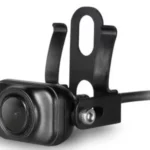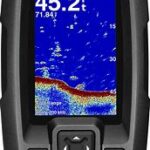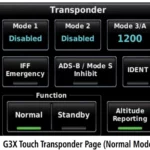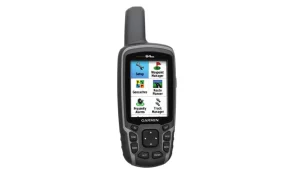
Garmin GPSMAP 64 Quick Start Manual

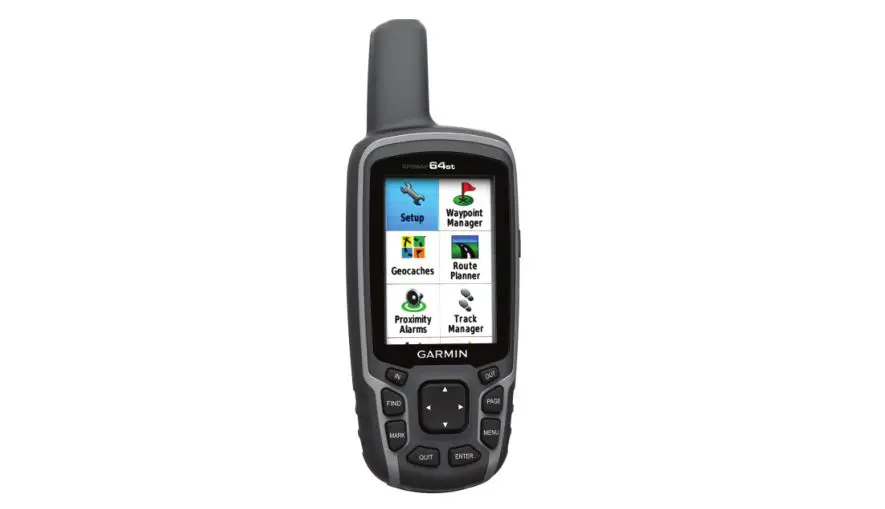
Getting Started

WARNING
See the Important Safety and Product Information guide in the product box for product warnings and other important information.
Device Overview
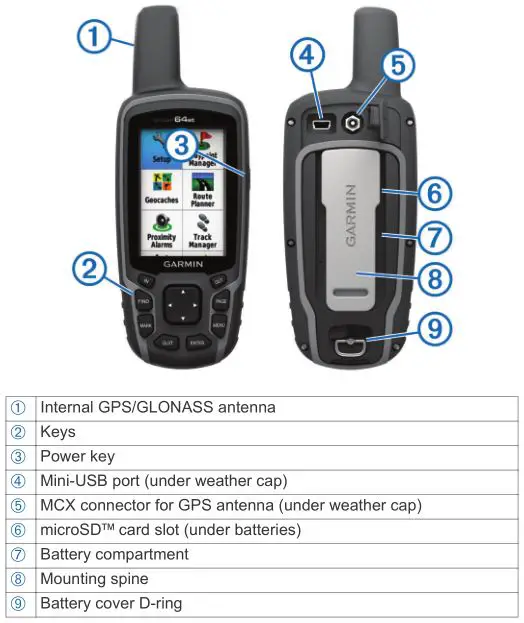
NOTE: The MCX connector is included on GPSMAP 64s and GPSMAP 64st models only.
Battery Information

WARNING
The temperature rating for the device may exceed the usable range of some batteries. Alkaline batteries can rupture at high temperatures.
Do not use a sharp object to remove batteries.

CAUTION
Contact your local waste disposal department to properly recycle the batteries.
NOTICE
Alkaline batteries lose a significant amount of their capacity as the temperature decreases. Use lithium batteries when operating the device in below freezing conditions.
Installing the NiMH Battery Pack
The device operates using the optional NiMH battery pack (purchased separately) or two AA batteries (Installing Batteries ).
- Turn the D-ring counter-clockwise, and pull up to remove the cover.
- Locate the battery pack CD (1).
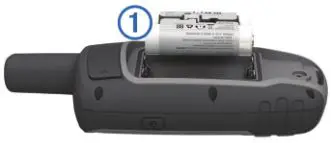
- Insert the battery pack, observing polarity.
- Gently press t he battery pack in to place.
- Replace the battery cover, and turn the D-ring clockwise.
Charging the Battery Pack
NOTICE
To prevent corrosion, thoroughly dry the mini-USB port, the weather cap, and the surrounding area before charging or connecting to a computer.
Do not attempt to use the device to charge a battery that was not provided by Garmin®. Attempt in g to charge a battery that was not provided by Garmin can damage the device and void the warranty.
Before you can connect the straight connector of the USB cable to your device, you may have to remove optional mount accessories.
NOTE: The battery will not charge when outside t he temperature range of 32° to 122°F (0° to 50°C).
You can charge the battery using a standard wall outlet or a USB port on your compute r.
- Pull up the weather cap CD from the mini-USB port (2).

- Plug the small end of the USB cable in to t he mini-U SB port.
- Plug the USB end of the cable into the AC adapter or a computer USB port.
- Plug the AC adapter into a standard wall outlet. When you connect the device to a power source, the device turns on.
- Charge the battery completely.
Installing Batteries
The handheld device operates using two AA batteries (not included). Use NiMH or lithium batteries for best results.
- Turn the D-ring counter-clockwise, and pull up to remove the cover.
- Insert two AA batteries, observing polarity.
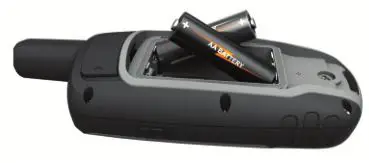
- Replace the battery cover, and turn the D-ring clockwise.
- Hold Power Button.
- Select Setup > System > AA Battery Type.
- Select Alkaline, Lithium, Traditional NiMH, or Precharged NiMH.
Turning On the Device
Hold Power Button.
Acquiring Satellite Signals
It may take 30 to 60 seconds to acquire satellite signals.
- Go outdoors to an open area.
- If necessary, turn on the device.
- Wait while the device searches for satellites. A question mark flashes while the device determines your location.
- Select Power Button to open the status page. Network Icon shows the GPS/GLONASS signal strength.
When the bars are green, the device has acquired satellite signals.
Keys
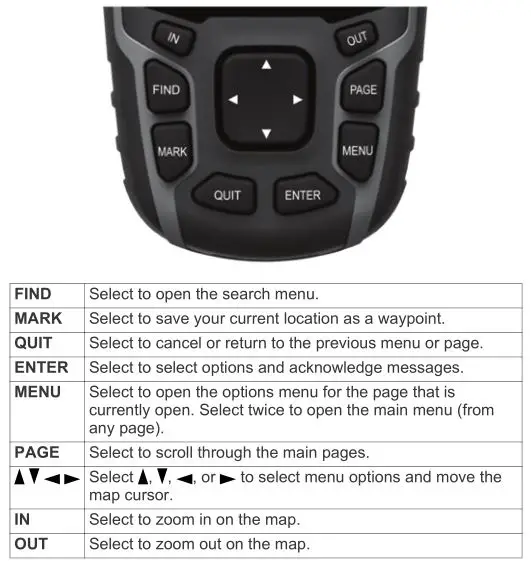
Navigation
Waypoints
Waypoints are locations you record and store in t he device.
Creating a Waypoint
You can save your current location as a waypoint.
- Select MARK.
- If necessary, select a field to make changes to the waypoint.
- Select Done.
Navigating to a Waypoint
- From the main menu, select FIND > Waypoint s.
- Select a waypoint.
- Select G o.
Editing a Waypoint
Before you can edit a waypoint, you must create a waypoint.
- Select W ay point Manager.
- Select a waypoint.
- Select an item to edit, such as the name.
- Enter the new information, and select Go
Deleting a Waypoint
- Select Waypoint Manager.
- Select a waypoint.
- Select MENU > Delete.
Routes
A route is a sequence of waypoints or locations that leads you to your final destination.
Creating a Route
- Select Route Pl anner > Create Route > Sel ec t First Point.
- Select a category.
- Select the first point in the route .
- Select Use.
- Select Select N ex t Point to add additional points to the route.
- Select QUIT to save the route.
Navigating a Saved Route
Before you can navigate using a saved route, you must create a route.
- Select FIND > Route s.
- Select a route.
- Select Go
Tracks
A track is a recording of your path. The track log contains information about points along the recorded path, including time, location, and elevation for each point.
Viewing the Current Track
- From the main menu, select Track Manager > Current Track.
- Select an option:
• To show the current track on the map, select View Map.
• To show the elevation plot for the current track, select Elevation Plot.
Navigating a Saved Track
Before you can navigate a saved track, you must save a track.
1 Select FIND > Track s.
2 Select a saved track.
3 Select Go
Map
∧ represents your location on the map. As you travel, ∧ moves and leaves a track log (trail). Waypoint names and symbols appear on t he map. When you are navigating to a destination, your route is marked with a colored line on the map.
Changing the Map Orientation
- From the map, select MENU.
- Select Setup Map > Orientation.
- Select an option:
• Select North Up to show north at the top of t he page.
• Select Track Up to show your current direction of travel at the top of t he page.
• Select Automotive Mode to show an automotive perspective with the direction of travel at the top.
Measuring Distance on the Map
You can measure the distance between two locations.
- From the map, select a location.
- Select MENU > Measure Di stance.
- Move the pin to another location on the map.
Compass
When navigating, A points to your destination, regardless of the direction you are moving. When A points toward the top of the electronic compass, you are traveling directly toward your destination. If A points any other direction, turn until it points toward the top of the compass.
Calibrating the Compass
Before you can calibrate the electronic compass, you must be outdoors, away from objects that influence magnetic fields, such as cars, buildings, or overhead power lines.
The device has a 3-axis electronic compass (GPSMAP 64s and GPSMAP 64st models only). You should calibrate the compass after moving long distances, experiencing temperature changes, or changing the batteries.
- From the compass, select MENU.
- Select Calibrate Compass > Start.
- Follow the on-screen instructions.
Navigating with Sight ‘N Go
You can point the device at an object in the distance, lock in the direction, and navigate to the object.
NOTE: Sight ‘N Go is ava il able only on the GPSMAP 64s and GPSMAP 64st.
- Select Sight ‘N Go.
- Point the device at an object.
- Select Lock Direction > Set Course.
- Navigate using the compass.
Trip Computer
The trip computer displays your current speed, average speed, maximum speed, trip odometer, and other helpful statistics. You can customize the trip computer layout, dashboard, and data fields.
Device Information
Specifications
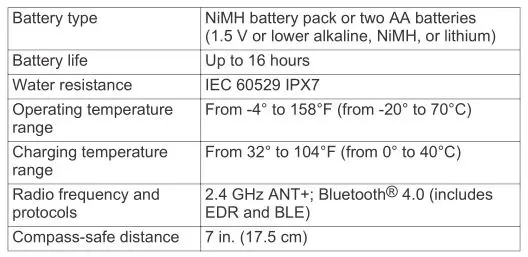
Calibrating the Barometric Altimeter
You can manually calibrate the barometric altimeter if you know the correct elevation or the correct barometric pressure.
NOTE: The barometric altimeter is available only on the GPSMAP 64s and GPSMAP 64s t.
- Go to a location where the elevation or barometric pressure is known.
- Select PAGE > Elevation Plot > MENU > Calibrate Altimeter.
- Follow the on-screen instructions.
Customizing the Data Fields
You can customize the data fields displayed on each main page.
- Open the page for which you will change the data fields.
- Select MENU.
- Select Change Data Fields.
- Select the new data field.
- Follow the on-scree n instructions.
Support and Updates
Garmin Express™ provides easy access to these services for Garmin devices. Some services may not be available for your device.
- Product registration
- Product manuals
- Software updates
- Map updates
- Vehicles, voices, and other extras
Setting Up Garmin Express
- Plug the small end of the USB cable into the port on the device.
- Plug the larger end of the USB cable into an available USB port on your computer.
- Go to www.garmin.com/express.
- Follow the on-screen instructions.
Getting More Information
You can find more information about this product on the Garmin website.
- Go to www.garmin.com/outdoor.
- Go to www.garmin.com/learn in gcenter.
- Go to http://buy.garmin.com, or contact your Garmin dealer for information about optional accessories and replacement parts.
Getting the Owner’s Manual
You can get the latest owner’s manual from the web.
- Go to www.garmin.com/support.
- Select Manuals.
- Follow the on-screen instructions to select your product.
Adjusting the Backlight Brightness
Extensive use of screen backlighting can significantly reduce battery life. You can adjust the backlight brightness to maximize the battery life.
NOTE: The backlight brightness may be limited when the battery is low.
- Select Power Button.
- Use the slider to adjust the backlight level.
The device may feel warm when the backlight setting is high.
Selecting the Battery Type
- From the main me nu , select Setup > System > AA Battery Type.
- Select Alkaline, Lithium, Traditional NiMH, or Precharged NiMH.
Installing a Memory Card

Warnings
Do not use a sharp object to remove user-replaceable batteries.
You can install a microSD memory card in the handheld device for additional storage or pre-loaded maps.
- Turn the D-ring counter-clockwise, and pull up to remove the cover.
- Remove the battery.
- Slide the card holder (1) to Lock and lift up.
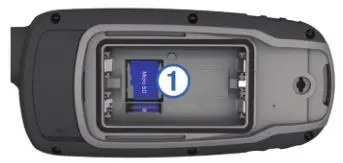
- Place the memory card with the gold contacts facing down.
- Close the card holder.
- Slide the card holder to (Lock Icon) to lock it.
- Replace the battery and cover.
Attaching the Wrist Strap
- Insert the loop of the wrist strap through the slot in the device.
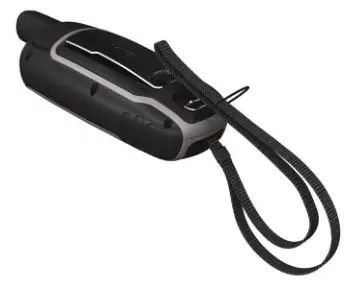
- Thread the other end of the strap through the loop, and pull it tight.
Attaching the Carabiner Clip
- Position the carabiner clip (1) in the slots on the mounting spine (2) of the device.
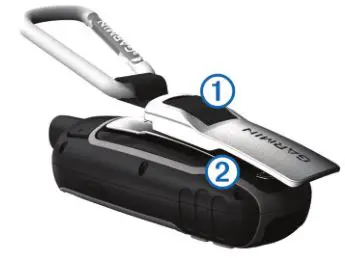
- Slide the carabiner clip up until it locks in place.
Removing the Carabine Clip
Lift up on the bottom of the carabiner clip, and slide the carabiner clip off the mounting spine.

Gar min ®, the Garmin logo, and GPSMAP® are trademarks of Garmin Ltd. or its subsidiaries, registered in the USA and other countries. ANT+ TM and Garmin Express™ are trademarks of Garmin Ltd. or its subsidiaries. These trademarks may not be used without the express permission of Garmin.
The Bluetooth® word mar k and logos are owned by the Bluetooth SIG, Inc. and any use of such marks by Gar min is under license. microSD TM and the microSDHC logo are trademarks of SD-3C, LLC. Other trademarks and trade names are those of their respective owners.
Garmin International, Inc.
1200 East 151st Street
Olathe, Kansas 66062, USA
Garmin (Europe) Ltd.
Liberty House, Hounsdown Business Park
Southampton, Hampshire, S040 9LR UK
Garmin Corporation
No. 68, Zhangshu 2nd Road, Xizhi Dis t.
New Taipei City, 221, Taiwan (R.O.C.)

© 2013- 2014 Garmin Ltd. or it s subsidiaries
